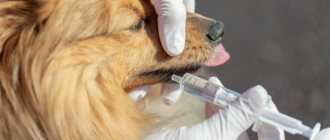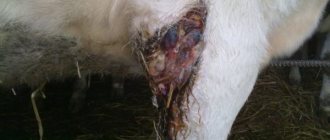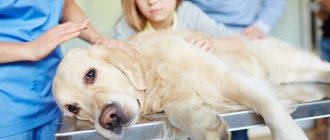Inflammation of the colon, or colitis, is a disease that occurs quite often in veterinary practice and is familiar to many dog owners. The pathological process has a sharply negative effect on the general health of the animal, provoking the development of dangerous changes in the digestive system.
Complicated colitis that is not treated in a timely manner leads to pathologies of the cardiovascular and hepatorenal systems, provokes perforation of the walls of the large intestine, anemia and dehydration.
It is necessary to promptly detect signs of pathology and show the pet to a veterinarian, since the diagnosis can be made on the basis of laboratory and instrumental studies. Based on the data obtained, the doctor will prescribe the most appropriate treatment and give advice on organizing further proper care for the animal.
It is also important to take measures to prevent the development of colitis in dogs. For these purposes, it is necessary to understand the reasons that provoke pathological changes of the inflammatory type in the large intestine.
Causes of colitis
There are many possible causes of colitis in dogs. These include:
Inflammatory diseases of the colon.
These diseases are named based on the predominant type of cells present in the inflamed colon.
- Lymphocytic-plasmacytic colitis
is the most common inflammatory bowel disease in dogs. The definitive cause of the disease is not known, but it is most likely caused by an overreaction of the immune system, - histiocytic colitis
is a disease that is characteristic of young Boxer dogs, - Granulomatous colitis
is a severe disease of the colon that resembles Crohn's disease in humans. The word "granulomatous" refers to specific types of inflammatory cells that are present in the colon in this disease, - purulent colitis
, - Eosinophilic colitis
– characterized by the presence of eosinophils (a type of white blood cell associated with allergic reactions or the presence of parasites) in the area of inflammation. The cause of eosinophilic colitis is unknown, but it may be a food allergy or parasitic infection.
Infectious agents such as:
- bacteria
(clostridia, salmonella, E. coli, campylobacter and others), - viruses
(coronavirus, parvovirus), - fungal agents
(causative agents of histoplasmosis), - parasitic worms
(nematodes), - protozoa
(Trichomonas, amoeba, balantidia, lamblia).
Food intolerance or allergies.
Food intolerances or allergic reactions can also cause colitis. In this case, the disease often occurs as a reaction to a specific protein, lactose or high fat content and certain food additives in the feed.
Eating disorders.
Poor diet can lead to acute colitis, which begins suddenly and usually does not last long. Examples of eating disorders can be overeating, spoiled food, foreign objects in food (bones, feathers), eating too fatty foods, etc.
Colon cancer.
Bowel tumors can cause symptoms similar to those that occur as a result of colitis, such as fresh (red) blood in the stool, mucus in the stool, tenesmus, increased frequency of bowel movements, and painful bowel movements. The most common type of colon cancer in dogs is adenocarcinoma and lymphosarcoma.
External (due to car injuries, etc.) or internal (when swallowing foreign objects, bones) injuries of the large intestine.
Intussusception.
Intussusception is the twisting of one section of the intestine inside another. Intussusception can cause partial or complete intestinal obstruction, which leads to the same symptoms as with colitis.
Pancreatitis.
Dogs with pancreatitis (inflammation of the pancreas) may also have symptoms of colitis, so it is important to get a correct and timely diagnosis.
Main symptoms of colitis in dogs
Constant digestive disorders in a dog are a reason to contact a veterinary clinic. Perhaps the dog has not just indigestion, but signs of incipient colitis.
During a dog's stool disorder, mucus and blood streaks are observed in the stool. These symptoms indicate an acute stage of the inflammatory process in the large intestine.
The symptoms of colitis in a dog are quite specific, it is difficult not to notice them. The basic signs of colitis are:
- tension of the animal during the act of defecation, constipation;
- pain in the digestive system (stomach cramps);
- belching after every meal;
- loud rumbling sound in the area of the intestines;
- gagging, often occurring for no particular reason;
- the appearance of a gray coating on the tongue;
- raising body temperature to subfebrile values and maintaining them at the same level (no more than 2 degrees above normal);
- increased frequency of myocardial contractions;
- the appearance of a repulsive odor from the animal’s mouth;
- flatulence and bloating;
- refusal of food and changes in taste preferences (the animal begins to eat objects that are not typical for it);
- weight loss and exhaustion of the dog.
Signs of chronic colitis may vary depending on what triggered the pathological process. Symptoms of colitis may be similar to tumor processes in the large intestine or intussusception.
Experts strongly do not recommend self-medication. Failure to see a doctor in a timely manner leads to serious complications in the form of ulcerative lesions, perforation areas and erosive formations. The disease becomes chronic and requires constant maintenance therapy.
Diagnostics
A complete medical history and a thorough physical examination (including a rectal examination and careful palpation of the abdomen) are the first steps a veterinarian will perform in the office to evaluate a dog with colitis.
Stool tests for the presence of parasites and protozoa.
Complete Blood Count - can detect high levels of white blood cells in the blood due to infectious and inflammatory diseases, and is also used to rule out anemia in a dog with high levels of blood in the stool.
Blood chemistry is usually normal in dogs with colitis, but this test will help identify abnormalities in other body systems (pancreas, liver) that may cause similar symptoms.
An abdominal x-ray is performed to rule out foreign objects and tumors in the dog's gastrointestinal tract, as well as to rule out enlarged lymph nodes and an enlarged prostate gland, which can put pressure on the large intestine, causing symptoms of colitis.
A chest x-ray is often recommended for older dogs and those animals suspected of having cancer to rule out lung metastases.
The trypsin-like immunoreactivity test can detect pancreatic enzyme deficiency in a dog with chronic diarrhea.
Ultrasound of the abdominal organs allows us to exclude intestinal tumors, intussusceptions, prostatitis in male dogs, and foreign bodies in the intestines.
Examination of the colon using a flexible fiber-optic endoscope allows direct visualization of the inner surface of the colon and detection of polyps, tumors, and chronic inflammation. During this procedure, a biopsy is taken from the inside of the colon for microscopic examination. Colonoscopy is usually performed after other tests have been performed that have not yielded a definitive diagnosis and the dog has not responded to conservative treatment.
Symptoms and manifestations
Spastic constipation is quite easy to recognize. Doctors Shulpekova Yu. O. and Ivashkin V. T. describe it as follows: “Constipation is spastic in nature, when the tone of some part of the intestine is increased and feces cannot overcome this place. Feces take on the appearance of sheep” (Shulpekova, Ivashkin, 2004, p. 49).
Unlike atonic ones, these forms of constipation are less likely to be prolonged; stool retention lasts no more than 2–5 days. Stool can be daily, but fragmented and in a very small volume.
Associated symptoms may include the following:
- pain and cramps in the abdomen;
- bloating, increased gas formation;
- false urge to defecate;
- feeling of heaviness in the stomach.
Pain and discomfort can be localized in different parts of the abdomen, it all depends on which part of the muscle is in spasm, where exactly there is an accumulation of dense feces and gases. Therefore, a symptom of spastic constipation may be pain in the side on the left or right, in the lower abdomen and in the epigastric region.
There are also nonspecific manifestations associated with intoxication of the body: nausea, headache, dizziness, increased sweating, pale skin, fatigue, decreased performance, irritability.
Treatment
Treatment for colitis in dogs may include:
- Quick transfer to a special diet. It is possible to introduce hypoallergenic diets to dogs with chronic diarrhea or to use diets that contain a “new” protein source (that the dog has not previously encountered). Dogs that respond to this therapy usually have a food allergy that is causing the colitis. High-fiber diets also help some animals with colitis.
- Antiparasitic and antiprotozoal drugs – for the treatment of dogs whose colitis is directly related to the presence of helminths or protozoa in the intestines.
- Treatment with antibiotics and antibacterial drugs can play an important role in the treatment of bacterial colitis. Typically, metronidazole, sulfasalazine and tylosin are used in this situation. These drugs have been used successfully as single agents, in combination with one another, or in combination with other drugs in therapy.
- Anti-inflammatory drugs and immunosuppressants (drugs that suppress the immune system) are used in the treatment of dogs with immune-mediated colitis and intestinal tumors identified by microscopic examination of biopsies obtained during colonoscopy.
- Drugs that affect intestinal motility are most often used to relieve symptoms rather than for long-term treatment of colitis.
Inflammatory bowel disease in dogs. Part 1
Inflammatory bowel diseases in dogs: relevance of the problem and various types of enteropathies
Inflammatory bowel diseases (IBD) are a group of chronic enteropathies, as emphasized by different authors.
These enteropathies are characterized by the presence of persistent or recurrent gastrointestinal disorders with signs of inflammation (1). According to research by Kenneth W. Simpson and Albert E. Jergens, IBD is believed to be a complex problem that is based on the body's genetic characteristics and complex interactions in which the intestinal microflora, food ingredients, the immune system and various environmental stimuli trigger the inflammatory process in the body. intestines.
To date, there is no clear understanding of the exact causes and pathogenesis of this group of diseases. Accordingly, there are no diagnostic and therapeutic approaches to the patient brought to a single standard. However, attempts are underway to create them.
The fact that certain breeds of dogs are predisposed to the disease clearly indicates that phenotypic characteristics are important for the development of the disease.
The authors (Kenneth W. Simpson and Albert E. Jergens) turn to medical sources that highlight the pathogenetic mechanism of the development of enteropathies in humans (in particular, Crohn's disease).
In humans, genetic predisposition to IBD has been documented for diseases such as Crohn's disease, ulcerative colitis, and celiac disease (celiac disease) (see 1, 2, 3).
Chinese researchers have demonstrated the role of bacterial infection in the development of ulcerative colitis. In particular, they note that the gut microbiota of patients with inflammatory bowel disease (IBD) differs from that of healthy individuals (4).
With reference to the medical literature, Simpson and Jergens note that in the case of Crohn's disease, genetic susceptibility is most often associated with defects in innate immunity, as exemplified by mutations in the immune receptor system encoded by the NOD2/CARD15 gene (1).
This gene (NOD2/CARD15) plays an extremely important role in antimicrobial defense mechanisms. It is present in large quantities in intestinal antigen-presenting cells and Paneth cells (5).
NOD2/CARD15 polymorphism may be a risk factor in many gastrointestinal diseases associated with weakened defense against bacteria and lead to the development of a chronic inflammatory process (6–9).
The authors refer to scientific publications and note that the predisposition to the disease in certain breeds of dogs, as well as the clinical response to antibiotics (for example, Boxers and German Shepherds), indicates their susceptibility to bacterial infections (similar to how this occurs in humans) (1, 10).
For example, Butt et al believe that the intestinal mucosa may become damaged due to bacterial overgrowth. Since this process is reversible, it should be given close attention (10).
The authors of another publication (Simpson KW, Dogan B., Rishniw M. and co-authors) concluded that boxer granulomatous colitis is associated with selective colonization of the mucosa by the adherent and invasive phenotype of Escherichia coli (11).
An article by Simpson and Jergens provides a table highlighting dog breeds that are predisposed to developing various types of enteropathies (1). To date, several types of enteropathies have been discovered, to which certain breeds of dogs are prone. The cause of the disease is not fully understood. This list includes the following breeds:
- Irish Setter (gluten sensitivity-mediated enteropathy (12)). In this publication, the authors state that in Irish Setters, gluten sensitivity-mediated enteropathy is controlled by one major autosomal recessive locus;
- Basenji (immunoproliferative diseases of the small intestine (13)). The study involved 8 adult Basenji dogs with immunoproliferative intestinal diseases. They had two similar patterns of illness: 1 – chronic, intractable diarrhea; and 2 – progressive weight loss. Also, along with these symptoms, they had skin lesions (alopecia of the auricles, necrosis and ulceration of the edge of the auricle). The cause of the development of skin lesions has not been established. Although malabsorption and maldigestion were found in these dogs, the authors of the article argue that further research is needed to fully understand the pathogenesis of this problem;
- Norwegian Husky (protein-losing enteropathy, lymphangiectasia, atrophic gastritis, gastric carcinoma (14)). The study authors performed postmortem examinations of 14 Norwegian huskies diagnosed with lymphangiectasia. Histological examination also revealed gastritis, caused by the presence of an increased number of mononuclear cells infiltrating the lamina propria of the stomach. Gastritis probably caused the development of stomach cancer;
- Rottweiler (protein-losing enteropathy, lymphangiectasia, crypt damage (15)). The authors conducted a retrospective study of 17 Rottweilers with protein-losing enteropathy. The prognosis for this disease is unfavorable. Most of these dogs died or were euthanized. Only 7 dogs (4%) achieved recovery after treatment (median time interval to next relapse was 21 months);
- Soft Coated Wheaten Terrier (protein-losing enteropathy, nephropathy (16)). In this study, the authors found that Soft Coated Wheaten Terriers with enteropathy/protein-losing nephropathy also had food intolerance;
- Shar Pei (cyanocobalamin deficiency (17)). This study demonstrated linkage disequilibrium of two microsatellite markers on canine chromosome 13 (DTR13.6 (P = 1.4 x 10(-6)) and REN13N11 (P = 1.5 x 10(-5)). This finding may suggest an inherited nature cobalamin deficiency in Shar Peis;
- boxer and French bulldog (granulomatous colitis (18, 19)). Escherichia coli is commonly found in the colonic mucosa of boxers with granulomatous colitis. This study found that Escherichia coli associated with granulomatous colitis is highly susceptible to antibiotic resistance. In such cases, antimicrobial therapy should be prescribed based on culture and antibiotic susceptibility testing results (18). Histiocytic ulcerative colitis was diagnosed in a 9-month-old French bulldog. The authors noted that this is the second case of this disease in dogs of this breed (French bulldogs are related to boxers) (19).
IBD can develop not only in dogs of the above-mentioned breeds. In addition, it is likely that the range of causes leading to enteropathy is much wider than we currently know.
Returning to the topic of the approach to groups of inflammatory bowel diseases, it should be noted that there is no clear understanding of the classification of these diseases. More important for a practicing physician is a clinical approach to the problem. A good classification of diseases is presented in the article by JRS Dandrieux. Although there are some parallels in the pathogenesis of IBD in dogs and humans, their therapeutic approaches are fundamentally different (20).
The author uses numerous literary references to illustrate this point (see below).
Thus, the first choice of treatment in human medicine is antibiotics and immunosuppressive drugs, which are used to reduce the inflammatory response and achieve a state of remission (21). In this article, the authors express the opinion that there are a significant number of drugs that can be used either alone or in combination. The main goal of therapy is to achieve remission, which can be established by histological examination of material obtained using endoscopic techniques.
However, in dogs, such therapy is not necessary, since a good clinical response can be obtained with the help of diet. Antibiotics and, less commonly, immunosuppressants may be necessary if there is no response to diet (22). At the same time, the authors note that the combined use of medications is an important factor in achieving remission in cats and dogs. A combination of medications and diet can be used already at the initial stage of therapy. This occurs due to the polyetiological nature of the disease (22, 23, 24).
In general, Dandrieux offers the following therapeutic steps for dogs and humans:
- sequential treatment regimen for humans: step 1 – mesalazine, antibiotics; step 2 – glucocorticosteroids; step 3 – azathioprine, metrotrexate, cyclosporine; step 4 – biotherapy;
- sequential treatment regimen for dogs: step 1 – diet correction (most dogs respond already at this stage); step 2 – antibiotics; Step 3 – immunosuppressants.
Chronic enteropathies are often classified according to how they respond to drug treatment. Thus, they distinguish: enteropathies that respond to changes in diet (food-responsive enteropathy: FRE); enteropathy that responds to antibiotics (antibiotic-responsive enteropathy: ARE); immunosuppressant-responsive enteropathy (IRE; also includes steroid-responsive diarrhea (SRD*)); and non-responsive enteropathy (NRE) (20).
The frequency of occurrence of the above-described enteropathies is demonstrated in the diagram (Fig. 1).
Rice. 1. (adapted from JRS Dandrieux): relative incidence of enteropathies. Diet-responsive enteropathy (FRE) is most commonly seen.
* The author of this classification (Dandrieux) notes that symptoms of enteropathy may include more than just diarrhea. Thus, he proposes to introduce the term IRE, which includes all possible symptoms observed within a given disease that respond to immunosuppressant therapy.
Read about the variants of enteropathy that respond to diet and the sequence of diets in the continuation of the article.
Author of the article
Ruppel Vladimir Vladimirovich
Literature:
1. Kenneth W. Simpson, Albert E. Jergens. Pitfalls and Progress in the Diagnosis and Management of Canine Inflammatory Bowel Disease. Vet Clin Small Anim 41 (2011) 381–398 2. Packey CD, Sartor RB. Interplay of commensal and pathogenic bacteria, genetic mutations, and immunoregulatory defects in the pathogenesis of inflammatory bowel diseases. J Intern Med 2008;263(6):597–606. 3. Perez LH, Butler M, Creasey T, et al. Direct bacterial killing in vitro by recombinant Nod2 is compromised by Crohn's disease-associated mutations. PLoS One 2010; 5(6):e10915. 4. Ulcerative colitis as a polymicrobial infection characterized by sustained broken mucus barrier Shui-Jiao Chen, Xiao-Wei Liu, Jian-Ping Liu, Xi-Yan Yang, Fang-Gen Lu. World J Gastroenterol. Jul 28, 2014; 20(28): 9468-9475 5. DA Elphick, YR Mahida. Paneth cells: their role in innate immunity and inflammatory disease. https://dx.doi.org/10.1136/gut.2005.068601 6. Gerhard Rogler The effects of NOD2/CARD15 mutations on the function of the intestinal barrier. Journal of Crohn's and Colitis. Volume 1, Issue 2, December 2007, Pages 53-60 7. Büning C, Genschel J, Bühner S, Krüger S, Kling K, Dignass A, Baier P, Bochow B, Ockenga J, Schmidt HH, Lochs H. Mutations in the NOD2/CARD15 gene in Crohn's disease are associated with ileocecal resection and are a risk factor for reoperation. Alimentary Pharmacology & Therapeutics. 2004 May 15;19(10):1073-8. 8. Y. Meddoura, S. Chaiba, A. Bousseloubb, N. Kaddachec, L. Kecilic, L. Gamarc, M. Nakkemouched, R. Djidjike, MC Abbadif, D. Charronh, TE Boucekkinec, R. Tamouza. NOD2/CARD15 and IL23R genetic variability in 204 Algerian Crohn's disease. Clinics And Research in Hepatology and Gastroenterology (2014) 38, 499-504 9. Nahla Azzam, Howaida Nounou, Othman Alharbi, Abedulrahman Aljebreen. Manal Shalaby. CARD15/NOD2, CD14 and Toll-like 4 Receptor Gene Polymorphisms in Saudi Patients with Crohn's Disease Int. J. Mol. Sci. 2012, 13(4), 4268-4280; https://doi.org/10.3390/ijms13044268 10. Batt RM, McLean L, Riley JE. Response of the jejunal mucosa of dogs with aerobic and anaerobic bacterial overgrowth to antibiotic therapy. Gut 1988; 29(4):473–82. 11. Simpson KW, Dogan B, Rishniw M, et al. Adherent and invasive Escherichia coli is associated with granulomatous colitis in boxer dogs. Infect Immun 2006;74(8):4778–92. 12. Garden OA, Pidduck H, Lakhani KH, et al. Inheritance of gluten-sensitive enteropathy in Irish Setters. Am J Vet Res 2000;61(4):462–8. 13. Breitschwerdt EB, Ochoa R, Barta M, et al. Clinical and laboratory characterization of Basenjis with immunoproliferative small intestinal disease. Am J Vet Res 1984;45(2):267–73. 14. Kolbjornsen O, PressCM, Landsverk T. Gastropathies in the Lundehund. I. Gastritis and gastric neoplasia associated with intestinal lymphangiectasia. APMIS 1994; 102(9):647–61. 15.Dijkstra M, Kraus JS, Bosje JT, et al. Protein-losing enteropathy in Rottweilers.Tijdschr Diergeneeskd 2010;135(10):406–12. 16. Vaden SL, Hammerberg B, Davenport DJ, et al. Food hypersensitivity reactions in Soft Coated Wheaten Terriers with protein-losing enteropathy or protein-losing nephropathy or both: gastroscopic food sensitivity testing, dietary provocation, and fecal immunoglobulin E. J Vet Intern Med 2000;14(1):60–7. 17. Grutzner N, Bishop MA, Suchodolski JS, et al. Association study of cobalamin deficiency in the Chinese Shar Pei. J Hered 2010;101(2):211–7. 18. Craven M, Dogan B, Schukken A, et al. Antimicrobial resistance impacts clinical outcome of granulomatous colitis in boxer dogs. J Vet Intern Med 2010;24(4):819–24 19. Tanaka H, Nakayama M, Takase K. Histiocytic ulcerative colitis in a French bulldog. J Vet Med Sci 003;65(3):431-3. 20. JRS Dandrieux. Inflammatory bowel disease versus chronic enteropathy in dogs: are they one and the same? Journal of Small Animal Practice (2016) 57, 589–599 21. Grevenitis, P., Thomas, A., & Lodhia, N. (2015) Medical therapy for inflammatory bowel disease. The Surgical Clinics of North America 95, 1159 – 1182 22. Malewska K, Rychlik A, Nieradka R, Kander M. Treatment of inflammatory bowel disease (IBD) in dogs and cats. Pol J Vet Sci. 2011;14(1):165-71. 23. Allenspach K. Clinical immunology and immunopathology of the canine and feline intestine. Vet Clin North Am Small Anim Pract. 2011 Mar;41(2):345-60 24. Handan Hilal Arslan Inflammatory Bowel Disease and Current Treatment Options in Dogs. American Journal of Animal and Veterinary Sciences 2022, 12 (3): 150.158 25. Marks, S. L., Laflamme, D. P., & Mcaloose, D. (2002) Dietary trial using a commercial hypoallergenic diet containing hydrolyzed protein for dogs with inflammatory bowel disease. Veterinary Therapeutics 3, 109 – 118 26. Mandigers, P. J., Biourge, V., van den Ingh, T. S., et al. (2010) A randomized, open-label, positively-controlled field trial of a hydrolyzed protein diet in dogs with chronic small bowel enteropathy. Journal of Veterinary Internal Medicine 24, 1350 – 1357 27. Kayode Garraway, Karin Allenspach, Albert Jergens, Inflammatory Bowel Disease in Dogs and Cats. https://todaysveterinarypractice.com/continuing-educationgastroenterologyinflammatory-bowel-disease-dogs-cats/ 28. Patrick Hensel, Domenico Santoro, Claude Favrot, Peter Hill and Craig Griffin Canine atopic dermatitis: detailed guidelines for diagnosis and allergen identification. 29. DAVID A. NELSEN JR Am Fam Physician. 2002 Dec 15;66(12):2259-2266. Gluten-Sensitive Enteropathy (Celiac Disease): More Common Than You Think 30. Oliver A. Garden, BVetMed, PhD; Heather Pidduck, PhD; Ken H. Lakhani, BSc; Dawn Walker, BSc; James LN Wood, BVetMed; Roger M. Batt, BVSc, PhD Inheritance of gluten-sensitive enteropathy in Irish Setters. AJVR, Vol 61, No. 4, April 2000 31. Batt RM, McLean L, Carter MW. Sequential morphological and biochemical studies of naturally occurring wheat-sensitive enteropathy in Irish Setter dogs. Dig Dis Sci 1987;32:184–194. 32. Hall EJ, Batt RM. Differential sugar absorption for the assessment of canine intestinal permeability: the cellobiose/mannitol test in gluten-sensitive enteropathy of Irish setters. Res Vet Sci 1991;51:83–87. 33. LOWRIE, M., GARDEN, OA, HADJIVASSILIOU, M., HARVEY, RJ, SANDERS, DS, POWELL, R. & GAROSI, L. The clinical and serological effect of a gluten-free diet in Border terriers with epileptoid cramping syndrome. Journal of Veterinary Internal Medicine 29, 1564–1568 (2015) 34. M. Lowrie, M. Hadjivassiliou, D.S. Sanders, O.A. Garden A presumptive case of gluten sensitivity in a border terrier: a multisystem disorder? December 3, 2016 | Veterinary Record (Veterinary Record: first published as 10.1136/vr.103910 on 26 October 2016. Downloaded from https://veterinaryrecord.bmj.com/ on 30 September 2022 by guest) 35. Dossin, O. & Lavoue, R. Protein -losing enteropathies in dogs. The Veterinary Clinics of North America. Small Animal Practice 41, 399 – 418 (2011) 36. Peterson, PB & Willard, MD Protein-losing enteropathies. The Veterinary Clinics of North America. Small Animal Practice 33, 1061 – 108 (2003)
Forecast
Most dogs with colitis have a good prognosis, especially those animals in which the underlying cause of the disease has been identified.
Most infectious and invasive causes of colitis are treatable.
The prognosis of animals with cancer depends on the type of cancer cells and their response to therapy. Patients with inflammatory colitis have the most unstable clinical course of colitis, possibly with frequent relapses. In this case, it is important that the dog owner remains in close contact with the attending veterinarian in order to monitor the general condition of the animal and be able to make changes to the prescription in a timely manner.
(c) Veterinary center for the treatment and rehabilitation of animals “Zoostatus”. Varshavskoe highway, 125 building 1. tel.
8 (499) 372-27-37
Recovery prognosis
In case of acute colitis caused by poisoning or an infectious component, symptomatic drug treatment associated with short fasting usually gives a positive result quite quickly, and after a few days the dog’s well-being is completely normalized. If intestinal inflammation has acquired a chronic form or is caused by idiopathic autoimmune causes (lymphocytic-plasmacytic, eosinophilic, granulomatous, histiocytic forms), complete recovery may never occur, but this does not mean that the animal is doomed. In such situations, labor-intensive work aimed at correcting the diet and selecting a diet that will reduce the frequency of clinical manifestations of the disease to a minimum comes to the fore.
The second factor, after proper nutrition, to improve the condition of a pet with autoimmune forms of colitis is the identification and elimination of the allergen that provokes an atypical reaction of the digestive tract.
Important! Relapses of chronic colitis in dogs are almost always the result of a departure from the doctor’s instructions regarding the animal’s diet and an attempt to treat the pet with something
–
something “tasty” from the human table.
What is colitis
Colitis is an inflammation of the colon, which is the main part of the large intestine. This part of the digestive system, which is the end, is where a large amount of water is absorbed, so the condition in this section will result in watery diarrhea, as we will see. In addition, colitis can be acute or chronic, which will manifest itself in various symptoms, even if they have general diarrhea.
Diagnosis of the disease
An accurate diagnosis can only be made after collecting an anamnesis, clinical laboratory tests, and examining the animal. Shown:
- General and biochemical blood test.
- Examination of feces.
- X-ray and ultrasound of the abdominal cavity.
Additionally, tests are prescribed for viral infections, incl. parvovirus enteritis, leptospirosis, viral hepatitis, plague. According to indications, an endoscopic examination is performed under anesthesia; it provides more information about the condition of the mucous membrane of the large and small intestine; if a tumor is suspected, a biopsy is taken.
Types of pathology and its manifestation
Enteritis and colitis can be primary or secondary, that is, they develop independently or are a consequence of another, internal disease (parvovirus in puppies).
Enterocolitis, as the primary form, is most often diagnosed in puppies under 6 months of age. After 7-8 years, a secondary form is discovered in dogs, developing as a consequence of diseases of the internal organs and gastrointestinal tract.
Forms of enterocolitis in dogs:
- Parasitic (presence of worms and protozoa in the gastrointestinal tract).
- Mechanical (constipation, foreign bodies, bezoars - everything that provokes inflammation in the small and large intestines).
- Toxic (effect of poisons, chemicals, irritating drugs).
- Nutritional (improper feeding, giving fatty, spicy, hot food, expired, moldy, etc.).
Enterocolitis can be distinguished by a number of specific manifestations, but at first it is similar to many diseases affecting the gastrointestinal tract. To make an accurate diagnosis, diagnostic testing will be required.
Prevention methods
- Timely deworming of the animal (once per quarter). Drugs are selected strictly according to the dog’s weight.
- Annual pet vaccination at any age.
- Feeding the dog high-quality food, following the regime.
- Do not treat your pet with food from the table: flour, sweets, fatty, smoked, etc.
- Hide household chemicals and other harmful substances out of reach.
- Strict control during the walk, make sure that the dog does not pick up anything from the ground or eat the feces of other animals.
- Don't give your dog long bones.
- Transfer your pet to a new type of food smoothly. Over the course of several days, add a small portion of the new diet to the old diet, gradually changing this ratio.
Colitis in dogs is a problem that every owner can face. The disease occurs even with proper feeding and in some cases has a genetic predisposition. You should consult a doctor if your pet has frequent episodes of indigestion. The veterinarian will tell you how to treat colitis and prescribe a diet to improve bowel function.
Forms of the disease and symptoms
Colitis can occur in one of three forms. In acute cases, all symptoms are most pronounced. The chronic type is most often a consequence of the acute form.
A more severe type of disease is ulcerative.
The disease can be recognized by the following symptoms:
- Abnormal stool. The feces become liquid, with mucus or blood visible in them, especially in the ulcerative form of the disease.
- Restless behavior. The animal experiences pain during bowel movements, spins in place, and whines.
- Disruption of the gastrointestinal tract. It manifests itself as flatulence (increased accumulation of gases in the intestines), rumbling in the stomach, and belching.
- A gray coating may appear on the animal's tongue, and the mouth smells bad.
- During the acute course of the disease, the dog’s temperature rises.
- The animal refuses to eat and loses weight.
Symptoms of chronic colitis are not so pronounced.
With this form, the animal experiences stool disturbances and a slight decrease in appetite, but the dog does not experience severe acute pain in the abdomen.
With colitis, the animal may refuse to eat and suffer from bowel dysfunction
Ulcerative colitis is characterized by the formation of ulcers on the lining of the large intestine. With this form, the pet empties its intestines up to 5-6 times a day. Feces are liquid and contain large amounts of mucus and blood. Anemia often accompanies the ulcerative form.
Diet features
For spastic constipation, limit foods and dishes that irritate the mucous membranes of the gastrointestinal tract. These include:
- vegetables rich in essential oils: radishes, garlic, onions, etc.;
- smoked meats, marinades, salty foods;
- pepper dishes and spices;
- fried, fatty foods;
- baked goods, soda, strong coffee and tea, etc.
The diet can be developed individually, taking into account the needs and general health of a person.
The basis of the daily diet can be cereals, low-fat fish, meat, and poultry. It is important to eat first courses - soups with low-fat broth. Fresh vegetables and fruits are good for constipation because they contain a lot of dietary fiber. But you should monitor your condition and intestinal reaction, especially if you are already taking additional fiber.
Mousses, fermented milk products, dried fruits, and cottage cheese casseroles are suitable as desserts. You should avoid confectionery, chocolate, cocoa, and baked goods.
Bread should be chosen from wholemeal flour. Fresh white bread is prohibited; small amounts of day-old bread are allowed. Rusks can make the problem worse.
Diet management
A dog with chronic colitis will need a strict diet to stay healthy and reduce bouts of diarrhea. Feeding for these dogs must be very controlled.
Their diet should be based exclusively and only on foods specialized for this pathology, which are hypoallergenic and rich in fiber and probiotics. Don't give them sweets or other types of food.
It is important that the pet owner understands the importance of feeding a dog suffering from chronic colitis and works with the veterinarian to restore the animal's health. Homemade food can also be prepared as long as the ingredients and quantities are approved by a veterinarian.
You will have to wait a few months to see the long-term benefits of this type of diet. In some cases, the dog can return to its normal diet as directed by the veterinarian.











